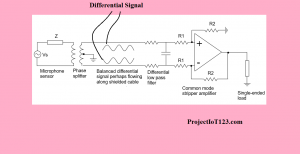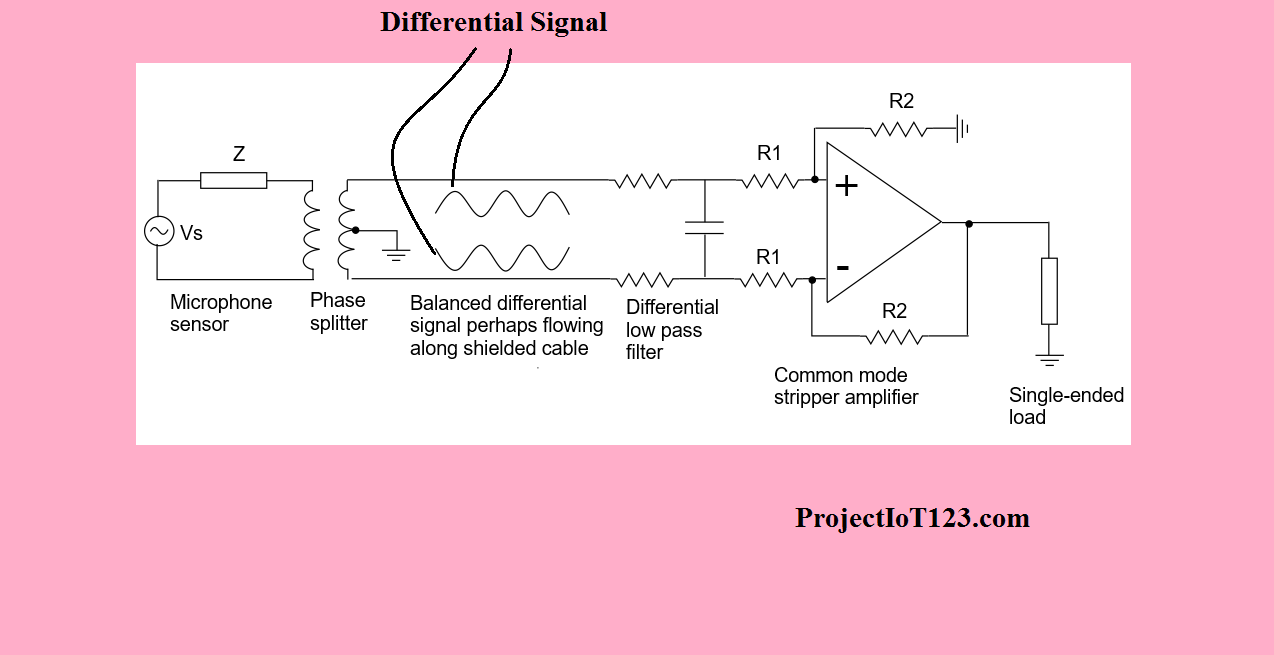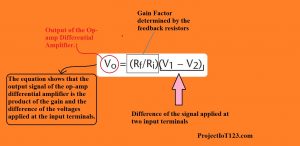Operational Amplifier as Differential Amplifier 1
[otw_is sidebar=otw-sidebar-1] In this post I will discuss about the Operational Amplifier as the Differential Amplifier. In the previous posts I have discussed the applications of the Operational Amplifier, ideal attributes of the Operational Amplifier, some common circuits of Operational Amplifier. I have discussed about the differential amplifier earlier here I will consider it in detail. As we know that the Operational Amplifier can be configured to perform a lot of functions for example its feedback network can designed to let it act as the integrator or differentiator. So the Operational Amplifier can be designed to work as the Differential Amplifier.
In this post I will discuss about the Operational Amplifier as the Differential Amplifier. In the previous posts I have discussed the applications of the Operational Amplifier, ideal attributes of the Operational Amplifier, some common circuits of Operational Amplifier. I have discussed about the differential amplifier earlier here I will consider it in detail. As we know that the Operational Amplifier can be configured to perform a lot of functions for example its feedback network can designed to let it act as the integrator or differentiator. So the Operational Amplifier can be designed to work as the Differential Amplifier.
[otw_is sidebar=otw-sidebar-3]
Operational Amplifier as Differential Amplifier
After reading this post you will learn about the differential amplifier, working of the differential amplifier, implementation of the differential amplifier using the Operational Amplifier, designing the Differential amplifier to meet the requirements and finally the advantages of the Operational Amplifier. so sit back keep reading and enjoy learning.
Differential Amplifier:
Differential Amplifier is very commonly used and an important type of Amplifier and finds application in Instrumentation, Signal conditioning circuits, Data processing systems, data acquisition systems and filters. The main principle behind working of the Differential Amplifier is very simple and this is that the Differential Amplifier amplifies the difference of the signals applied at the inputs. So the differential amplifier has two inputs and one output. One of the inputs is called the Inverting input terminal and the other is called the Non-Inverting Input terminal. The differential amplifier is intended to receive the differential signal and then amplifies the difference of the voltage level between each line. This kind of operation has a lot of advantages especially in measurement of signals as we will see in the next sections.
[otw_is sidebar=otw-sidebar-3]
Differential and single ended Signals:
Before diving deep into the discussion on the Operational Amplifier as the Differential Amplifier let us first understand the two important types of signals:
- Differential Signal.
- Single Ended Signal.
Differential Signal is the signal which is carried by two signal wires. Each wire carries the signal that is out of phase by 180 degrees with respect to the signal at the other wire. It is important to note here that the phase comparison is made with by comparing each signal with respect to the ground. So speaking precisely the differential signal is represented using two wires and the signal with respect to the ground on each wire is out of phase by 180 degrees to each other. On the other hand single ended signal as the name implies is the signal which has ground on one wire and the signal is carried on just one wire. This type of signal is called the Single-ended signal. The idea of the Differential Signal and Single ended Signal can be visualized using the following diagram:
[otw_is sidebar=otw-sidebar-3]
Operational Amplifier as Differential Amplifier:
Operational Amplifier can be designed to function as the Differential Amplifier. By the way Operational Amplifier as most of you already knew that is, basically the Differential Amplifier inherently. As we know that the Operational Amplifier has two input terminals and one output terminal. One of input terminals is called the inverting input terminal and the other is called non-inverting input terminal. From the discussion in the above section you must have figured out that the Operational Amplifier is the differential input and single ended output amplifier that is it accepts the differential signal at its inputs amplifies the difference of these input signals voltage levels and gives the single ended output at the output terminal. So the differential amplifier can be implemented using the Operational Amplifier. Before the discussing of the design and working of the Operational Amplifier as differential amplifier let us now see the circuit for the Operational Amplifier based differential amplifier which is shown below:
Notice in the figure that the circuit consists of the resistive feedback network and this feedback network has two parts one feeds the portion of the output signal at the inverting input signal and one part feeds the portion of the output signal at the non-inverting input terminal. The amount of output signal which is to be fed to the input terminals is determined by the resistance of the resistors which forms the voltage divider network at the feedback configuration and thus the gain factor by which the signal gets amplified depends entirely on the resistance of the resistors in the feedback network. The differential amplifier can be thought of as the inverting and non-inverting configurations combined together.
Note:
It is important here that the gain of each feedback network part should be perfectly matched that is the corresponding resistance of the resistors in the feedback network should be identical to each other so that the same portion of the output signal is fed to the inverting and non-inverting input terminal.
Although the operational amplifier is the differential amplifier inherently but it is useless without the feedback network as it will amplify the difference of the signals at the input terminals by such a large amount that the Operational Amplifier itself gets saturated.
The transfer function of the Operational Amplifier as the Differential Amplifier is shown in the following figure:
Advantages of Differential Amplifier:
[otw_is sidebar=otw-sidebar-2]
Let us now discuss the benefits that the differential amplifier offers. As mentioned previously that the Operational Amplifier finds applications in Signal conditioning circuits and the Instrumentation etc. it is because the Operational Amplifier Differential Amplifier is very effective in removing the common mode signal in the differential signal. This point can be understand by referring to the previous discussion that the Differential Amplifier amplifies the difference of the signal at its input terminals so any signal that is common between the signals will be eliminated and does not get amplified. So this amplifier is useful in measuring weak signals this is due to the reason that each signal carries some noise this noise is called the Electromagnetic Interference which is due to the power lines radiation and this noise rides on the signals to be measured. This EMI noise is common between the signal wires of the Differential Signal so the differential amplifier acts to process the signal by removing the noise from. Apart from this Operational Amplifier also amplifies the signal this performance makes it very popular in the analog circuit design.
That is all for now I hope this article would be helpful for you. In the next post I will come up with more interesting applications of the Operational Amplifier. Till then stay connected, keep reading and enjoy learning.



online shopping pharmacy india http://indiaph24.store/# indianpharmacy com
online pharmacy india